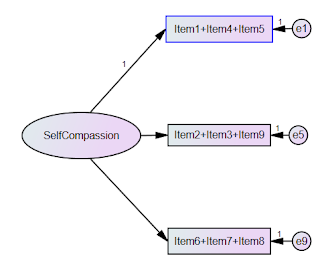Item Parcelling for Measurement Models
Item Parcelling = Combine the items in a factor and
use them as indicators
Parcelling is a compromise between the original SEM
(with all items intact) and a structural model with composite scores (where
respective items are totalled or averaged to arrive at a factor’s score).
Three ways to parcel:
1) Assign
the items in a factor randomly into 3 or 4 parcels
a. A good
option if all items have high loading
2) Distribute
items with high loading across 3 or 4 parcels
a. A
good option if some items have low loading
3) Use a
theory to create dimensions within the factor
In this example, we measure Self-Compassion as a
latent variable using 9 indicators (Item1 to Item9)
Figure 1. Original measurement model with 9 indicators
We can do item parcelling by assigning the items randomly to three
parcels. In this example, the first parcel is made of Item 1, 4 and 5, the
second parcel is made of Item 2, 3, and 9 and the rest of the items made the
third parcel. You could use a random number generator to get the numbers 1 to 9
as select the first three, second three, and the last three numbers. Notice for this example, we simple sum up the
three items within each parcel. Once we have these parcels, we can calculate
the estimates in AMOS as usual.
If we want to parcel using the second method, we can list the items based
on their loading (from biggest to smallest). Then, three items with the highest
loading will be assign to each parcel. The three items with the lowest loading
will be assigned to each parcel. The three items with the middle loading values
will accompany the top three and bottom three in each of the parcels. Using the
same diagram below, we can assume that Items 1,2 and 6 has the highest loading,
while Items 5, 9 and 8 has the lowest loading.
Figure 2. A measurement model with 3 parcels comprising
summed items
In the second example (Figure 3), the parcels are made
of averaged score of the items.
Figure 3. A measurement model with 3 parcels comprising
averaged items
Harris Shah
Abd Hamid
18/12/2019



Comments